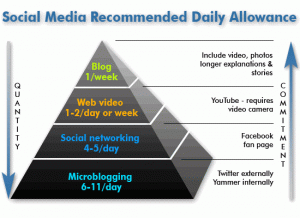Note: This post is part of a series providing fuller discussion for my 35 Social Media Theses. I welcome your feedback and comments to challenge and improve them.
In Thesis 1, I discussed how social media really aren’t completely new, since air was the original social medium. This leads us, however, to what is new:
Thesis 2: Electronic tools merely facilitate broader and more efficient transmission by overcoming inertia and friction.
What these electronic tools like Facebook, YouTube and Twitter do is not different in kind from what has happened with word of mouth since the dawn of civilization.
They just make it a whole lot easier.
People have always talked with friends and family about their experiences, including those with merchants and service providers. From which blacksmith did the best job with horseshoes a century ago to which dentist is best able to prevent pain, a huge portion of our “purchase” decisions have been and remain significantly affected by word-of-mouth.
As I mentioned in Thesis 1, word of mouth from patients and their families has been the top source of information for people who prefer Mayo Clinic, and it’s been that way for more than a century.
Now that word just spreads a lot faster.
So when someone writes on our Mayo Clinic Facebook wall, it’s available for the world to see…
…but more importantly, it may show up in her friends’ news feeds.
Social tools just mean that people are sharing with a lot more people, with a lot less effort.
Offline word of mouth is still more prevalent and more powerful than online, even with the new tools. Hearing a friend talk in person about an experience makes a deeper impression. And if a person, let’s call him Bob, is telling his friend Carl about his mysterious illness and his frustration that it hasn’t been diagnosed, if Carl tells him right then, at the point of need, about his good experience and recommends that Bob try Mayo, that’s obviously going to have deeper impact than a wall posting on Facebook.
But social media can have a broader impact. In the example above, Shannon’s wall posting was potentially visible to 300 million Facebook users, and the sharing she did with her Facebook friends was effortless. The act of writing was the act of sharing.
Likewise, when Rhonda King told the story of bringing her son Trevor to Mayo Clinic for a second opinion on the Mayo Clinic YouTube channel:
…It was seen by many more people than she could have spoken with personally. As of this writing, in fact, it’s been viewed more than 4,400 times. And while nothing is as powerful as face-to-face dialogue, I would argue that the impression Brenda made via video is both broad and deep, for those who have taken time to listen to what she had to say.
So while social media really are as old as human speech, as Thesis 1 says, there is something new and exciting about the ease with which messages can spread with social tools.
I say “merely” in Thesis 2 to emphasize the continuity of social tools with offline word-of-mouth. But don’t think that “merely” minimizes their impact. As we will discuss in the next two theses, social media tools are revolutionary in what they are doing to the anomalous mass media era of the 20th century.

